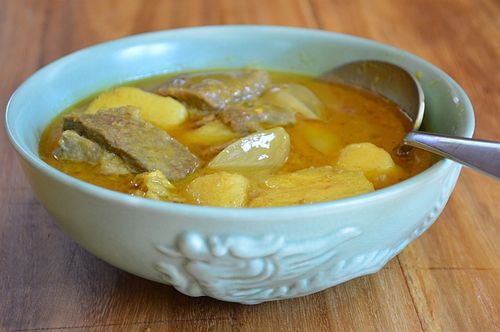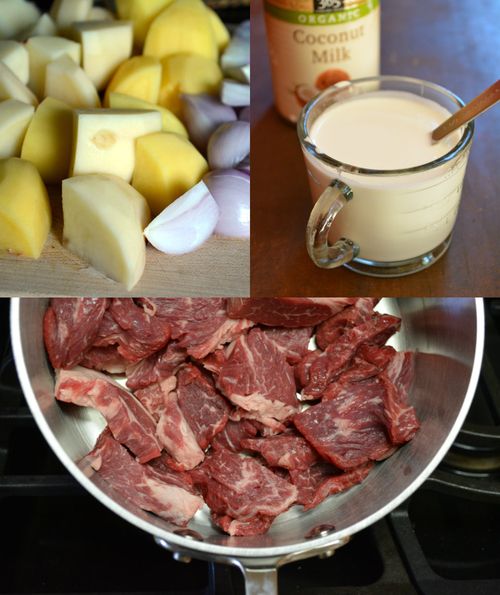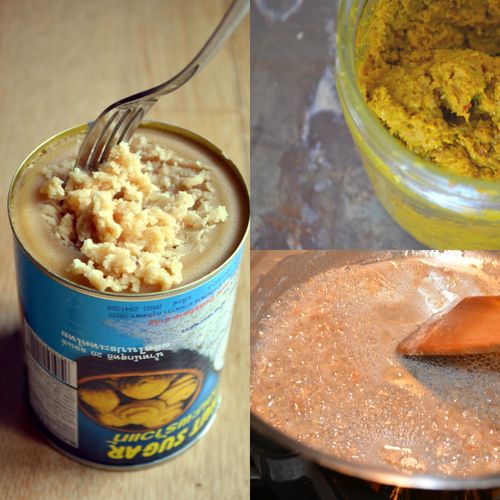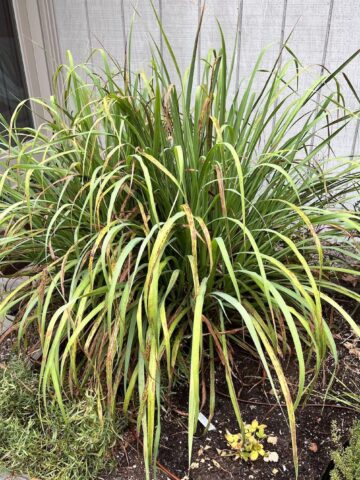
Over the weekend, I used Pok Pok chef/owner Andy Ricker’s recipe for Thai beef and potato yellow curry in the October issue of Saveur magazine. I’d spent quite some time making his Thai yellow curry paste so I wanted to use the curry and see what else I could glean from his recipes.
First off, I’d somehow assumed that yellow curry was only for chicken (Viet folks make similar kinds of yellow curry with chicken and potato) but Ricker prescribed beef and a long simmering in unseasoned coconut milk. I was curious about the pairing of beef in a Southeast Asian curry. Perhaps it would lend depth to the mellow yellow curry paste?
Cooking the beef in coconut milk reminded me of how Italian bolognese sauce requires simmering ground meat in milk and white wine. The result would no doubt be rich, despite the small amount of meat involved. Smart low-meat cooking.
Another thing that intrigued me about Ricker’s recipe was the notion of “cracking” coconut cream (what you get at the top when the container of coconut milk is left to sit for 1 or 2 days). That is, the thick coconut cream is cooked until the solids disappeared and the oil remained. Then a good cup of the paste went into the pot and fried. Yes, a cup of paste seemed like a heck of a lot but I’d tasted the paste and it was not frighteningly strong. (Maybe the stuff from the stores are made to be extra strong?)
Cracking and frying the curry paste made sense. A number of Malaysian and Indonesian seasoning pastes are often fried to meld flavors before the protein and liquid are added. And, using the natural sweet nuttiness of coconut oil ties the entire dish together, kind of like rendering chicken fat for a chicken and rice claypot.
Ricker also called for adding water to second simmering. His curry promised to be lighter, runnier than what you’d normally get at Thai restaurants. Runny curries are what I remember from eating in Chiang Mai in the early 1990s. We sat down at a market curry stall, pointed to a couple of curry pots and the vendor dished it up on tin plates. At room temperature, the curry was ethereal tasting, not thick and creamy. You tasted the curry paste’s nuanced flavors and it didn’t weigh you down.
I always let my curries rest before serving. With the Thai yellow curry, we ate it in a near-tepid state with rice, boiled grean beans and some sliced cucumber for refreshing crunch; I also made canh, a clear Viet quick soup.
A batch of this curry yielded about 8 servings and after reading Austin Bush’s piece on kaeng karii, I added a side of chiles and soy sauce to subsequent meals of Thai yellow curry. We mixed them into the rice and curry at the table for spirited heat and savory depth. As with stews, this curry tastes better as it ages.
So how was the curry over all? It was excellent, full of complexity yet well balanced enough to be elegant. The beef imparted gravitas. Thumbs up on the DIY Thai yellow curry paste and this curry. I now have a cup of yellow curry paste left in the fridge for another run, maybe with chicken and potatoes. Ricker's Thai cookbook coming out soon and judging from this little curry experiment, good things are bound to come from from the publication.
Note that I used a canned coconut palm sugar that I had to scrape with a fork; it was okay stuff but very compact so use a little less than what’s called for or the curry may be on the sweet side.
Related posts and links:
- Thai Yellow Curry Paste recipe
- Leela at She Simmers delves into Thai yellow curry, clarifying what the term means and includes a link to her recipe Bangkok-based photographer Austin Bush gives a quick lowdown on the Thai capitol’s best spots for kaeng karii, as well as thedifferences between Chinese and Muslim renditions
RECIPE
Thai Yellow Curry with Beef and Potatoes
Yield: 8 servings, with 2 or 3 other dishes
Ingredients:
- Two 13.5 oz / 390 ml cans coconut milk (3 ⅓ cups / 810 ml total)
- 1 ½ pounds beef chuck
- 1 cup Thai Yellow Curry Paste, at room temperature
- 3 medium regular shallots, or 10 small red Asian shallots
- 3 large Yukon gold, red, or white potatoes
- 2 tablespoons grated palm sugar or light brown sugar
- 1 tablespoon fish sauce
- Cooked jasmine rice, for serving
- 2 or 3 sliced Thai, serrano, jalapeno, or Fresno chiles, for serving
- Regular soy sauce, for serving
Instructions:
- Use a spoon to skim off 1 cup of the thicker coconut cream floating at the top of the can. Set aside. Pour the remaining coconut milk into a 4-quart (1 L) pot.
- Trimmed and cut the beef into thick strips, each about 2 inches (5 cm) long and ½ inch (1.25 cm). Add to the pot. The beef should be covered. Add water, if not. Bring to simmer over medium heat, then cook for about 1 hour, occasionally stirring, until tender. Using a slotted spoon, transfer the beef to a bowl and cover to keep warm. Measure out 1 ½ cups (360 ml) of coconut milk and set aside. Save extra for another use.*
- Pour the reserved coconut cream into a 5 or 6-quart (1.25 or 1.5 L) pot. Heat over medium heat, stirring occasionally, for about 15 minutes, until the oil separates and there’s little of the white solids that remain. Some golden bits are fine.
- Add the curry paste, then cook for 5 to 7 minutes, until slightly darkened and fragrant. Add the reserved coconut milk and 3 cups of water. Bring to a boil before adding the beef, shallot, and potatoes. Lower the heat to gently simmer for about 40 minutes, until the potatoes are tender.
- Stir in the sugar and fish sauce. Turn off the heat and let the curry rest and cool for about 20 minutes before serving with the rice. If there's too much oil/fat at the top, skim some off; refrigerating overnight will make the job easier. Offer sliced chiles and soy sauce to guests to add to their curry. Enjoy this Thai style, on a plate with fork and spoon.
*Employ the extra beefy coconut milk to moisten a vegetable stir-fry
or enrich soup. It’ll keep for days in the fridge.



















apearlofagirl says
would you use this paste for a seafood curry?
Andrea Nguyen says
It would totally work, especially with fish steaks. Great idea.
apearlofagirl says
yes!, and a quick cook too .. maybe a julienned red bell pepper at the end for crunch .. i've recently become enamored with fish AND potatoes - more an english and french thing, i guess.
i may look for andy ricker's recommended Trachang yellow curry paste, tho' .. thank you again, andrea!
plasterers bristol says
Yummy that looks real good, i love trying out different curry's
Simon
marty says
k i tried this out and it comes out so freaking spicy you can't taste anything else! why would you say to put 20 dried chilies in there!!??
seriously did not turn out at all, pretty much have to throw it away.
why can't i find a yellow curry recipe that turns out like the thai restaurant by my house??!
Andrea Nguyen says
Marty, what kind of dried chiles did you use? I followed Andy Ricker's recipe and for 1 batch of of the paste, you use 20 chiles. For 1 batch of curry, you use half of the paste, which means you have 10 dried chiles. You have to tweak the curry to your taste.
Yellow curry is very mild. Sorry that it didn't agree with you. Ask your local Thai restaurant what they use. It likely comes from a can or tub and they likely add a lot of sugar to it.
Ricker's recipe is pretty true to what you'd get in Thailand, which is not necessarily what you get at many Thai-American restaurants.